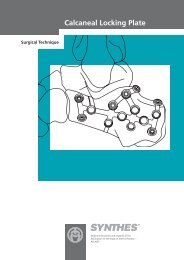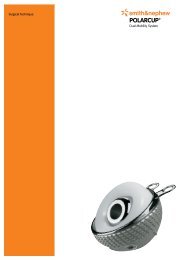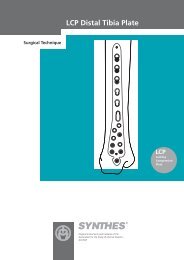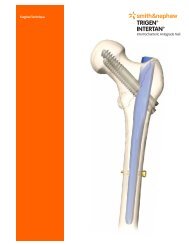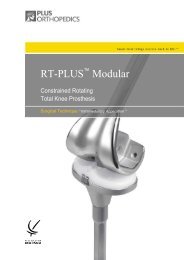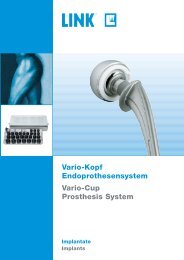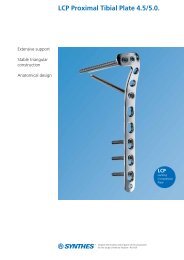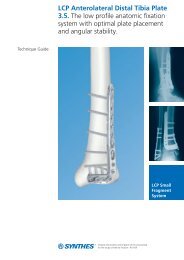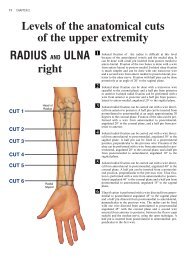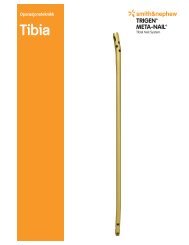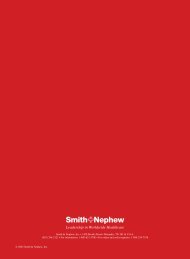R etroB utton A C L R econstruction
R etroB utton A C L R econstruction
R etroB utton A C L R econstruction
Create successful ePaper yourself
Turn your PDF publications into a flip-book with our unique Google optimized e-Paper software.
R<strong>etroB</strong><strong>utton</strong> for Femoral ACL<br />
R<strong>econstruction</strong> and RetroConstruction<br />
Surgical Technique<br />
NEW<br />
R<strong>etroB</strong><strong>utton</strong> ACL R<strong>econstruction</strong>
STRONGER and SIMPLER ACL GRAFT FIXATION<br />
The Arthrex R<strong>etroB</strong><strong>utton</strong> passes through a 3 mm guide pin hole to preserve cortical bone for enhanced cortical<br />
bone fixation and eliminates the need for overdrilling with larger diameter cannulated drills.<br />
The sturdy, titanium b<strong>utton</strong> in two length options has a continuous ultra-high molecular weight polyethylene<br />
(UHMWPE) loop with wider surface profile to provide superior strength, stiffness and load distribution.<br />
The R<strong>etroB</strong><strong>utton</strong>, in conjunction with retrodrilling or transtibial femoral socket drilling techniques, provides<br />
the meticulous surgeon with every anatomical tunnel placement option.<br />
STRONGER<br />
• 12 or 15 mm titanium b<strong>utton</strong><br />
fits through 3 mm hole<br />
for greater cortical contact<br />
• Continuous UHMWPE loop<br />
available in 10 different lengths<br />
• Wide, atraumatic loop<br />
profile protects graft integrity<br />
SIMPLER<br />
• No overdrilling<br />
• Simplified measuring technique with<br />
RetroConstruction and standard<br />
transtibial drilling<br />
• R<strong>etroB</strong><strong>utton</strong> is passed through a<br />
3 mm guide pin hole, reducing steps<br />
and preserving bone<br />
• Implant is preassembled and ready to<br />
use out of the package<br />
• Self-flipping b<strong>utton</strong> design
FEMORAL SOCKET PREPARATION and MEASUREMENT<br />
OPTION ONE: RetroDrill<br />
The RetroDrill allows unmatched flexibility in femoral socket preparation for ligament<br />
r<strong>econstruction</strong> and the R<strong>etroB</strong><strong>utton</strong> facilitates minimally invasive fixation in sockets that<br />
cannot be reached by straight screwdrivers or crosspin guides.<br />
1<br />
Place the femoral guide into the knee.<br />
Push the RetroDrill Guide Sleeve to<br />
bone before “retrodrilling” and note the<br />
transosseous length on the RetroDrill<br />
sleeve (in this example, 65 mm). The Retro-<br />
B<strong>utton</strong> pin is then drilled into the joint and<br />
engages the RetroCutter.<br />
2<br />
Set the rubber ring to the end of the guide sleeve. The<br />
socket is created by drilling on forward and pulling the<br />
drill back, away from the bone. Socket length is read by<br />
counting the 5 mm laser line marks between the guide<br />
sleeve and the rubber ring (in this example, 35 mm).
OPTION TWO: Transtibial Femoral Preparation<br />
The R<strong>etroB</strong><strong>utton</strong> technique for transtibial drilling simplifies measuring and eliminates overdrilling of the cortex.<br />
a<br />
1 2<br />
Preload the R<strong>etroB</strong><strong>utton</strong> pin into the Transtibial Femoral<br />
ACL Drill Guide (TTG) by placing the end of the pin<br />
through the cannulated tip (a). The R<strong>etroB</strong><strong>utton</strong> pin has<br />
a spade tip that should rest just above the cannulation of<br />
the TTG.<br />
The TTG is inserted into the knee through the tibial<br />
tunnel and the tip is placed in the “over the top” position.<br />
(Alternatively the TTG may be placed through the<br />
anteromedial portal). The R<strong>etroB</strong><strong>utton</strong> pin is advanced<br />
into the femur until the lateral cortex is felt, the drill is<br />
then stopped.The intraosseous length is given by reading<br />
the measurement on the R<strong>etroB</strong><strong>utton</strong> pin closest to<br />
the femoral notch. In this case, 5 or 50 mm.<br />
3 4<br />
Alternatively, the pin is drilled to the 20 mm mark and<br />
the long R<strong>etroB</strong><strong>utton</strong> Depth Guide is placed over the<br />
tip of the R<strong>etroB</strong><strong>utton</strong> pin and advanced to bone.<br />
Intraosseous length is read where the tip of the pin<br />
ends on the depth guide, in this case, 50 mm.<br />
The Cannulated Headed Reamer is then placed over<br />
the R<strong>etroB</strong><strong>utton</strong> pin and the femoral socket is drilled to<br />
the desired length. In this case, 30 mm.
IMPLANT SIZING<br />
R<strong>etroB</strong><strong>utton</strong>s are available in 12 mm and 15 mm titanium b<strong>utton</strong> lengths and loop sizes from 15 mm to 60 mm in 5 mm<br />
increments. Use the following formula to choose the appropriate length of loop.<br />
For 12 mm titanium b<strong>utton</strong>s:<br />
Transosseous length - socket length + 10 = R<strong>etroB</strong><strong>utton</strong> loop length<br />
For 15 mm titanium b<strong>utton</strong>s:<br />
Transosseous length - socket length + 12 = R<strong>etroB</strong><strong>utton</strong> loop length<br />
Example: for 12 mm titanium b<strong>utton</strong>:<br />
Transosseous length 50 mm - socket length 30 mm + 10 = 30 mm loop length<br />
GRAFT PREPARATION<br />
The graft is folded in half over the R<strong>etroB</strong><strong>utton</strong> loop and tension is applied. A sterile marker is used to draw a line on the graft<br />
a distance that equals the femoral socket from the looped end of the graft. This will be used to indicate when the b<strong>utton</strong> has<br />
exited the femoral cortex.<br />
femoral socket length<br />
GRAFT PASSING FEMORAL FIXATION<br />
1<br />
2<br />
Passing sutures are pulled and the graft is passed into<br />
the femoral socket. When the line on the graft reaches<br />
the orifice of the femoral socket, the b<strong>utton</strong> will exit the<br />
femoral cortex and begin to flip horizontally.<br />
Distal traction on the graft and<br />
release of the passing sutures<br />
facilitates complete deployment<br />
of the b<strong>utton</strong>. The passing<br />
suture may now be removed<br />
and tibial fixation completed.
Ordering Information<br />
12 mm titanium R<strong>etroB</strong><strong>utton</strong>s:<br />
R<strong>etroB</strong><strong>utton</strong>, 15 mm loop<br />
R<strong>etroB</strong><strong>utton</strong>, 20 mm loop<br />
R<strong>etroB</strong><strong>utton</strong>, 25 mm loop<br />
R<strong>etroB</strong><strong>utton</strong>, 30 mm loop<br />
R<strong>etroB</strong><strong>utton</strong>, 35 mm loop<br />
R<strong>etroB</strong><strong>utton</strong>, 40 mm loop<br />
R<strong>etroB</strong><strong>utton</strong>, 45 mm loop<br />
R<strong>etroB</strong><strong>utton</strong>, 50 mm loop<br />
R<strong>etroB</strong><strong>utton</strong>, 55 mm loop<br />
R<strong>etroB</strong><strong>utton</strong>, 60 mm loop<br />
AR-1588-15<br />
AR-1588-20<br />
AR-1588-25<br />
AR-1588-30<br />
AR-1588-35<br />
AR-1588-40<br />
AR-1588-45<br />
AR-1588-50<br />
AR-1588-55<br />
AR-1588-60<br />
15 mm titanium R<strong>etroB</strong><strong>utton</strong>s:<br />
R<strong>etroB</strong><strong>utton</strong>, long, 15 mm loop<br />
R<strong>etroB</strong><strong>utton</strong>, long, 20 mm loop<br />
R<strong>etroB</strong><strong>utton</strong>, long, 25 mm loop<br />
R<strong>etroB</strong><strong>utton</strong>, long, 30 mm loop<br />
R<strong>etroB</strong><strong>utton</strong>, long, 35 mm loop<br />
R<strong>etroB</strong><strong>utton</strong>, long, 40 mm loop<br />
R<strong>etroB</strong><strong>utton</strong>, long, 45 mm loop<br />
R<strong>etroB</strong><strong>utton</strong>, long, 50 mm loop<br />
R<strong>etroB</strong><strong>utton</strong>, long, 55 mm loop<br />
R<strong>etroB</strong><strong>utton</strong>, long, 60 mm loop<br />
AR-1589-15<br />
AR-1589-20<br />
AR-1589-25<br />
AR-1589-30<br />
AR-1589-35<br />
AR-1589-40<br />
AR-1589-45<br />
AR-1589-50<br />
AR-1589-55<br />
AR-1589-60<br />
Accessories:<br />
R<strong>etroB</strong><strong>utton</strong> Drill Pin, 3 mm (required for transtibial technique)<br />
R<strong>etroB</strong><strong>utton</strong> Depth Guide, long (required for transtibial technique)<br />
Transtibial Femoral ACL Drill Guide (TTG), 4 mm, for 6 and 7 mm drill holes, purple<br />
Transtibial Femoral ACL Drill Guide (TTG), 5 mm, for 7 and 8 mm drill holes, red<br />
Transtibial Femoral ACL Drill Guide (TTG), 6 mm, for 8 and 9 mm drill holes, green<br />
Transtibial Femoral ACL Drill Guide (TTG), 7 mm, for 10 and 11 mm drill holes, gold<br />
Transtibial Femoral ACL Drill Guide (TTG), 8 mm, for 12 and 13 mm drill holes, blue<br />
Cannulated Headed Reamer, 7 mm<br />
Cannulated Headed Reamer, 7.5 mm<br />
Cannulated Headed Reamer, 8 mm<br />
Cannulated Headed Reamer, 8.5 mm<br />
Cannulated Headed Reamer, 9 mm<br />
Cannulated Headed Reamer, 9.5 mm<br />
Cannulated Headed Reamer, 10 mm<br />
Cannulated Headed Reamer, 10.5 mm<br />
AR-1590<br />
AR-1270<br />
AR-1806<br />
AR-1803<br />
AR-1804<br />
AR-1801<br />
AR-1805<br />
AR-1407<br />
AR-1407.5<br />
AR-1408<br />
AR-1408.5<br />
AR-1409<br />
AR-1409.5<br />
AR-1410<br />
AR-1410.5<br />
RetroDrill Guide Set (AR-1866RS):<br />
Tibial ACL Guide for RetroConstruction, 45˚<br />
AR-1866R-45<br />
Tibial ACL Guide for RetroConstruction, 50˚<br />
AR-1866R-50<br />
Tibial ACL Guide for RetroConstruction, 55˚<br />
AR-1866R-55<br />
Tibial PCL Guide Marking Hook<br />
for RetroConstruction, 60˚<br />
AR-1880R<br />
Femoral ACL Guide for RetroConstruction, 120˚<br />
AR-1888R<br />
Femoral ACL Guide for RetroConstruction, 120˚,<br />
6 mm offset tip, 120˚ AR-1888RH<br />
Femoral ACL Guide for RetroConstruction, 90˚<br />
AR-1888RP<br />
Femoral PCL Guide for RetroConstruction, 80˚<br />
AR-1848R<br />
RetroDrill Guide Sleeve<br />
AR-1876R<br />
Long Adapteur Drill Guide C-Ring<br />
AR-1875L<br />
Jacob’s Chuck Handle<br />
AR-1415<br />
Chuck Key<br />
AR-8241<br />
RetroDrill Guide Set Instrument Case, autoclavable<br />
AR-1866RC<br />
Femoral ACL Guide for RetroConstruction, 120˚, 5 mm offset tip, 120˚<br />
AR-1888RH-05<br />
Femoral ACL Guide for RetroConstruction, 120˚, 4 mm offset tip, 120˚<br />
AR-1888RH-04<br />
RetroDrill Disposables:<br />
RetroCutter, 6 mm<br />
RetroCutter, 6.5 mm<br />
RetroCutter, 7 mm<br />
RetroCutter, 7.5 mm<br />
RetroCutter, 8 mm<br />
RetroCutter, 8.5 mm<br />
RetroCutter, 9 mm<br />
RetroCutter, 9.5 mm<br />
RetroCutter, 10 mm<br />
RetroCutter, 10.5 mm<br />
RetroCutter, 11 mm<br />
RetroCutter, 12 mm<br />
RetroDrill Guide Pin, 3 mm, cannulated (for RetroCutters)<br />
AR-1204R-06S<br />
AR-1204R-065S<br />
AR-1204R-07S<br />
AR-1204R-075S<br />
AR-1204R-08S<br />
AR-1204R-085S<br />
AR-1204R-09S<br />
AR-1204R-095S<br />
AR-1204R-10S<br />
AR-1204R-105S<br />
AR-1204R-11S<br />
AR-1204R-12S<br />
AR-1250RP
Arthrex, Inc.<br />
1370 Creekside Boulevard, Naples, Florida 34108-1945 • USA<br />
Tel: 239-643-5553 • Fax: 239-598-5534 • Web site: www.arthrex.com<br />
Arthrex GmbH<br />
Liebigstrasse 13, D-85757 Karlsfeld/München • Germany<br />
Tel: +49-8131-59570 • Fax: +49-8131-5957-565<br />
Arthrex Iberoamerica<br />
Howard Hughes Tower, 6701 Center Drive West, Suite 550, Los Angeles, California 90045 • USA<br />
Tel: 310-670-6080 • Fax: 310-670-6087<br />
Arthrex S.A.S.<br />
5 Avenue Pierre et Marie Curie, 59260 Lezennes • France<br />
Tel: +33-3-20-05-72-72 • Fax: +33-3-20-05-72-70<br />
Arthrex Canada<br />
Lasswell Medical Co., Ltd., 405 Industrial Drive, Unit 21, Milton, Ontario • Canada L9T 5B1<br />
Tel: 905-876-4604 • Fax: 905-876-1004 • Toll-Free: 1-800-224-0302<br />
Arthrex GesmbH<br />
Triesterstrasse 10/1 • 2351 Wiener Neudorf • Austria<br />
Tel: +43-2236-89-33-50-0 • Fax: +43-2236-89-33-50-10<br />
Arthrex BvbA<br />
Technologiepark Satenrozen, Satenrozen 1a, 2550 Kontich • Belgium<br />
Tel: +32-3-2169199 • Fax: +32-3-2162059<br />
Arthrex Ltd.<br />
Unit 16, President Buildings, Savile Street East, Sheffield S4 7UQ • England<br />
Tel: +44-114-2767788 • Fax: +44-114-2767744<br />
Arthrex Hellas - Medical Instruments SA<br />
103, Ethnikis Antistasseos str., N. Psichico 154 51 Athens • Greece<br />
Tel: +30-210-8079980 • Fax: +30-210-8000379<br />
Arthrex Sverige AB<br />
Turbinvägen 9, 131 60 Nacka • Sweden<br />
Tel: +46-8-556 744 40 • Fax: +46-8-556 744 41<br />
Arthrex Korea<br />
Rosedale Building #1904, 724 Sooseo-dong, Gangnam-gu, Seoul 135-744 • Korea<br />
Tel: +82-2-3413-3033 • Fax: +82-2-3413-3035<br />
Arthrex Mexico, S.A. de C.V.<br />
Insurgentes Sur 600 Mezanine, Col. Del Valle Mexico D.F. 03100 • Mexico<br />
Tel: +52-55-91722820 • Fax: +52-55-56-87-64-72<br />
This description of technique is provided as an educational tool and clinical aid to assist properly licensed medical professionals<br />
in the usage of specific Arthrex products. As part of this professional usage, the medical professional must use<br />
their professional judgment in making any final determinations in product usage and technique.<br />
In doing so, the medical professional should rely on their own training and experience and should conduct<br />
a thorough review of pertinent medical literature and the product’s Directions For Use.<br />
U.S. PATENT NOS. 5,350,383; 6,716,234 and PATENT PENDING<br />
© Copyright Arthrex Inc., 2007. All rights reserved. LT0186A<br />
#LT0189#



